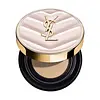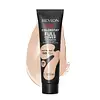Yves Saint Laurent Touche Eclat Glow Pact Cushion Versus Revlon ColorStay Full Cover Matte Foundation
What's inside
What's inside
 Key Ingredients
Key Ingredients

 Benefits
Benefits

 Concerns
Concerns

 Ingredients Side-by-side
Ingredients Side-by-side

Water
Skin ConditioningMethyl Trimethicone
Skin ConditioningDimethicone
EmollientEthylhexyl Methoxycinnamate
UV AbsorberTitanium Dioxide
Cosmetic ColorantEthylhexyl Salicylate
UV AbsorberDiphenylsiloxy Phenyl Trimethicone
Skin ConditioningButylene Glycol Dicaprylate/Dicaprate
EmollientLauryl PEG-9 Polydimethylsiloxyethyl Dimethicone
Skin ConditioningGlycerin
HumectantPentylene Glycol
Skin ConditioningButylene Glycol
HumectantTrisiloxane
Skin ConditioningPEG-10 Dimethicone
Skin ConditioningMagnesium Sulfate
Acrylates/Stearyl Acrylate/Dimethicone Methacrylate Copolymer
Phenoxyethanol
PreservativeDimethicone Crosspolymer
Emulsion StabilisingDisteardimonium Hectorite
StabilisingLauroyl Lysine
Skin ConditioningEthylhexylglycerin
Skin ConditioningStearic Acid
CleansingPolyhydroxystearic Acid
EmulsifyingAlumina
AbrasiveTriethoxycaprylylsilane
Calophyllum Inophyllum Seed Oil
AntimicrobialIsododecane
EmollientLecithin
EmollientIsopropyl Myristate
EmollientIsostearic Acid
CleansingEthylhexyl Palmitate
EmollientAdenosine
Skin ConditioningPolyglyceryl-3 Polyricinoleate
EmulsifyingDisodium EDTA
Silica Silylate
EmollientBHT
AntioxidantPropylene Carbonate
SolventTocopherol
AntioxidantJasminum Sambac Flower Extract
MaskingParfum
MaskingWater, Methyl Trimethicone, Dimethicone, Ethylhexyl Methoxycinnamate, Titanium Dioxide, Ethylhexyl Salicylate, Diphenylsiloxy Phenyl Trimethicone, Butylene Glycol Dicaprylate/Dicaprate, Lauryl PEG-9 Polydimethylsiloxyethyl Dimethicone, Glycerin, Pentylene Glycol, Butylene Glycol, Trisiloxane, PEG-10 Dimethicone, Magnesium Sulfate, Acrylates/Stearyl Acrylate/Dimethicone Methacrylate Copolymer, Phenoxyethanol, Dimethicone Crosspolymer, Disteardimonium Hectorite, Lauroyl Lysine, Ethylhexylglycerin, Stearic Acid, Polyhydroxystearic Acid, Alumina, Triethoxycaprylylsilane, Calophyllum Inophyllum Seed Oil, Isododecane, Lecithin, Isopropyl Myristate, Isostearic Acid, Ethylhexyl Palmitate, Adenosine, Polyglyceryl-3 Polyricinoleate, Disodium EDTA, Silica Silylate, BHT, Propylene Carbonate, Tocopherol, Jasminum Sambac Flower Extract, Parfum
Dimethicone
EmollientIsodecyl Neopentanoate
EmollientWater
Skin ConditioningPEG/PPG-19/19 Dimethicone
EmulsifyingTrisiloxane
Skin ConditioningTrimethylsiloxysilicate
EmollientC13-16 Isoparaffin
SolventMica
Cosmetic ColorantAdipic Acid/Neopentyl Glycol Crosspolymer
Boron Nitride
AbsorbentDimethicone/Bis-Isobutyl PPG-20 Crosspolymer
EmollientC10-13 Isoparaffin
SolventAlumina
AbrasiveButylene Glycol
HumectantCymbidium Grandiflorum Flower Extract
Skin ConditioningDimethicone/Silsesquioxane Copolymer
Disteardimonium Hectorite
StabilisingEthylhexyl Palmitate
EmollientGlycerin
HumectantHydrogen Dimethicone
Lactobacillus/Eriodictyon Californicum Ferment Extract
Skin ConditioningLilium Candidum Bulb Extract
Skin ConditioningMalva Sylvestris Extract
AstringentMethicone
EmollientPolyisobutene
Propylene Carbonate
SolventSalicylic Acid
MaskingSerica
HumectantSilica Dimethyl Silylate
EmollientSilica Silylate
EmollientSodium Acrylates Crosspolymer-2
AbsorbentSorbitan Sesquioleate
EmulsifyingTetrasodium EDTA
Tocopherol
AntioxidantTriethoxycaprylylsilane
1,2-Hexanediol
Skin ConditioningCaprylyl Glycol
EmollientPhenoxyethanol
PreservativeIron Oxides
CI 77891
Cosmetic ColorantTitanium Dioxide
Cosmetic ColorantZinc Oxide
Cosmetic ColorantDimethicone, Isodecyl Neopentanoate, Water, PEG/PPG-19/19 Dimethicone, Trisiloxane, Trimethylsiloxysilicate, C13-16 Isoparaffin, Mica, Adipic Acid/Neopentyl Glycol Crosspolymer, Boron Nitride, Dimethicone/Bis-Isobutyl PPG-20 Crosspolymer, C10-13 Isoparaffin, Alumina, Butylene Glycol, Cymbidium Grandiflorum Flower Extract, Dimethicone/Silsesquioxane Copolymer, Disteardimonium Hectorite, Ethylhexyl Palmitate, Glycerin, Hydrogen Dimethicone, Lactobacillus/Eriodictyon Californicum Ferment Extract, Lilium Candidum Bulb Extract, Malva Sylvestris Extract, Methicone, Polyisobutene, Propylene Carbonate, Salicylic Acid, Serica, Silica Dimethyl Silylate, Silica Silylate, Sodium Acrylates Crosspolymer-2, Sorbitan Sesquioleate, Tetrasodium EDTA, Tocopherol, Triethoxycaprylylsilane, 1,2-Hexanediol, Caprylyl Glycol, Phenoxyethanol, Iron Oxides, CI 77891, Titanium Dioxide, Zinc Oxide
 Reviews
Reviews

Ingredients Explained
These ingredients are found in both products.
Ingredients higher up in an ingredient list are typically present in a larger amount.
Alumina is another name for the compound aluminum oxide. It is used as a thickener, absorbent, and abrasive.
As an absorbent, alumina can give a mattifying effect. It is used in mineral sunscreens to help coat nano-sized filters, such as titanium dioxide. By increasing the size of the UV filters, these ingredients stay on the skin for a longer time. By coating small sized ingredients, alumina helps thicken a product.
Alumina may be used as an abrasive, or exfoliant.
Alumina is naturally occurring in the mineral corundum. Certain varieties of corundum create rubies and sapphires. Corundum is also the crystalline form of alumina.
Learn more about AluminaButylene Glycol (or BG) is used within cosmetic products for a few different reasons:
Overall, Butylene Glycol is a safe and well-rounded ingredient that works well with other ingredients.
Though this ingredient works well with most skin types, some people with sensitive skin may experience a reaction such as allergic rashes, closed comedones, or itchiness.
Learn more about Butylene GlycolDimethicone is a type of synthetic silicone created from natural materials such as quartz.
What it does:
Dimethicone comes in different viscosities:
Depending on the viscosity, dimethicone has different properties.
Ingredients lists don't always show which type is used, so we recommend reaching out to the brand if you have questions about the viscosity.
This ingredient is unlikely to cause irritation because it does not get absorbed into skin. However, people with silicone allergies should be careful about using this ingredient.
Note: Dimethicone may contribute to pilling. This is because it is not oil or water soluble, so pilling may occur when layered with products. When mixed with heavy oils in a formula, the outcome is also quite greasy.
Learn more about DimethiconeDisteardimonium Hectorite comes from the clay mineral named hectorite. It is used to add thickness to a product.
It can also help stabilize a product by helping to disperse other ingredients.
Hectorite is a rare, white clay mineral.
Learn more about Disteardimonium HectoriteEthylhexyl Palmitate, also known as octyl palmitate, is created from 2-ethylhexyl alcohol and palmitic acid. It is a fatty acid ester.
The fatty acid content of Ethylhexyl Palmitate makes it an emollient. Emollients help soften and hydrate your skin by trapping moisture within.
Ethylhexyl Palmitate is also used to help improve the texture of cosmetics. It helps other ingredient dissolve in products and help disperse ingredients more evenly.
You'll likely find this ingredient in sunscreen, as it is often used to mix UV-blocking ingredients such as avobenzone and ethylhexyl triazone.
It can also help stabilize the fragrances in a product as a fragrance fixative.
Ethylhexyl Palmitate can be used to substitute mineral oil.
Due to its high fatty acid content, it may not be fungal-acne safe.
Learn more about Ethylhexyl PalmitateGlycerin is already naturally found in your skin. It helps moisturize and protect your skin.
A study from 2016 found glycerin to be more effective as a humectant than AHAs and hyaluronic acid.
As a humectant, it helps the skin stay hydrated by pulling moisture to your skin. The low molecular weight of glycerin allows it to pull moisture into the deeper layers of your skin.
Hydrated skin improves your skin barrier; Your skin barrier helps protect against irritants and bacteria.
Glycerin has also been found to have antimicrobial and antiviral properties. Due to these properties, glycerin is often used in wound and burn treatments.
In cosmetics, glycerin is usually derived from plants such as soybean or palm. However, it can also be sourced from animals, such as tallow or animal fat.
This ingredient is organic, colorless, odorless, and non-toxic.
Glycerin is the name for this ingredient in American English. British English uses Glycerol/Glycerine.
Learn more about GlycerinPhenoxyethanol is a preservative that has germicide, antimicrobial, and aromatic properties. Studies show that phenoxyethanol can prevent microbial growth. By itself, it has a scent that is similar to that of a rose.
It's often used in formulations along with Caprylyl Glycol to preserve the shelf life of products.
This ingredient is a solvent. It helps dissolve active ingredients and alter the texture of products.
Propylene Carbonate is commonly used in makeup and with clay, such as montmorillonite or bentonite.
Studies show this ingredient to be safe for cosmetics. When it is undiluted, it can cause skin irritation. (It is always diluted in skincare and makeup). This ingredient is water-soluble.
Propylene Carbonate is created from propylene glycol and carbonic acid.
Learn more about Propylene CarbonateSilica Silylate is a siloxane polymer, meaning it is made up of silicon and oxygen atoms. It is not soluble in water.
This ingredient is a white powder with oil-absorbing, emollient, and anticaking properties.
Titanium dioxide is a mineral UV filter widely used in sunscreens and cosmetics.
It is one of only two UV filters officially classified as “mineral” by regulatory agencies, the other being zinc oxide.
Titanium dioxide provides broad-spectrum protection mostly in the UVB and UVAII range, with some protection in the UVAI range.
While its UVA protection isn’t as strong as zinc oxide’s, the difference is minor.
A common myth is that mineral UV filters reflect UV light. However, modern research shows titanium dioxide absorbs UV radiation like chemical filters (~95% absorption & 5% reflection).
Thanks to its non-irritating nature, titanium dioxide is suitable for sensitive, acne-prone, or redness-prone skin. It is unlikely to cause "eye sting" like other sunscreen ingredients.
A major drawback of this ingredient is its white cast and thick texture. This is why mineral sunscreens often leave a white cast and are less cosmetically elegant than chemical/hybrid sunscreens.
To improve white cast and spreadability, micronized or nano-sized titanium dioxide is often used.
There are ongoing concerns surrounding nano-titanium oxide's impact on marine ecosystems.
There is no conclusive evidence that any form of titanium oxide (or any other sunscreen ingredients) will cause harm to marine ecosystems or coral reefs. The science is still developing but many consumers are keeping a close eye on this issue.
Please note, many destinations have reef-safety sunscreen rules. For instance, the U.S. Virgin Islands advises all visitors to use non-nano mineral sunscreens.
Nano mineral sunscreens once raised safety concerns about absorption into skin.
Extensive research has shown that they do not penetrate healthy or damaged skin; they remain safely on the surface and the top layer of dead skin (stratum corneum).
You'll likely find titanium dioxide bundled with alumina, silica, or dimethicone. These ingredients help make titanium dioxide highly photostable; this prevents it from interacting with other formula components under UV light.
Learn more about Titanium DioxideTocopherol (also known as Vitamin E) is a common antioxidant used to help protect the skin from free-radicals and strengthen the skin barrier. It's also fat soluble - this means our skin is great at absorbing it.
Vitamin E also helps keep your natural skin lipids healthy. Your lipid skin barrier naturally consists of lipids, ceramides, and fatty acids. Vitamin E offers extra protection for your skin’s lipid barrier, keeping your skin healthy and nourished.
Another benefit is a bit of UV protection. Vitamin E helps reduce the damage caused by UVB rays. (It should not replace your sunscreen). Combining it with Vitamin C can decrease sunburned cells and hyperpigmentation after UV exposure.
You might have noticed Vitamin E + C often paired together. This is because it is great at stabilizing Vitamin C. Using the two together helps increase the effectiveness of both ingredients.
There are often claims that Vitamin E can reduce/prevent scarring, but these claims haven't been confirmed by scientific research.
Learn more about TocopherolTriethoxycaprylylsilane is a silicone used to bind and stabilize ingredients.
As an emulsifier, it helps prevent ingredients from separating. This can help elongate the shelf life of products.
Triethoxycaprylylsilane is often used to coat mineral sunscreens ingredients to help give a better feel. It also helps reduce oxidative stress in sunscreens.
Learn more about TriethoxycaprylylsilaneTrisiloxane is a type of silicone.
Water. It's the most common cosmetic ingredient of all. You'll usually see it at the top of ingredient lists, meaning that it makes up the largest part of the product.
So why is it so popular? Water most often acts as a solvent - this means that it helps dissolve other ingredients into the formulation.
You'll also recognize water as that liquid we all need to stay alive. If you see this, drink a glass of water. Stay hydrated!
Learn more about Water